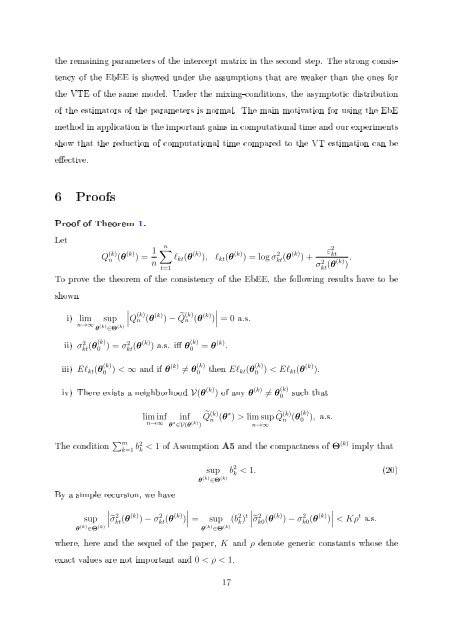MPRA
n?u=RePEc:pra:mprapa:75582&r=ets
n?u=RePEc:pra:mprapa:75582&r=ets
Create successful ePaper yourself
Turn your PDF publications into a flip-book with our unique Google optimized e-Paper software.
the remaining parameters of the intercept matrix in the second step. The strong consistency<br />
of the EbEE is showed under the assumptions that are weaker than the ones for<br />
the VTE of the same model. Under the mixing-conditions, the asymptotic distribution<br />
of the estimators of the parameters is normal. The main motivation for using the EbE<br />
method in application is the important gains in computational time and our experiments<br />
show that the reduction of computational time compared to the VT estimation can be<br />
eective.<br />
6 Proofs<br />
Proof of Theorem 1.<br />
Let<br />
Q (k)<br />
n (θ (k) ) = 1 n<br />
n∑<br />
l kt (θ (k) ), l kt (θ (k) ) = log σkt(θ 2 (k) ε 2 kt<br />
) +<br />
σkt 2 (θ(k) ) .<br />
t=1<br />
To prove the theorem of the consistency of the EbEE, the following results have to be<br />
shown<br />
i) lim<br />
n→∞<br />
∣ ∣∣Q (k)<br />
sup n (θ (k) ) −<br />
θ (k) ∈Θ (k)<br />
n (θ (k) ) ∣ = 0 a.s.<br />
˜Q<br />
(k)<br />
ii) σ 2 kt (θ(k) 0 ) = σ 2 kt (θ(k) ) a.s. i θ (k)<br />
0 = θ (k) .<br />
iii) El kt (θ (k)<br />
0 ) < ∞ and if θ (k) ≠ θ (k)<br />
0 then El kt (θ (k)<br />
0 ) < El kt (θ (k) ).<br />
iv) There exists a neighborhood V(θ (k) ) of any θ (k) ≠ θ (k)<br />
0 such that<br />
lim inf<br />
n→∞<br />
inf<br />
θ ∗ ∈V(θ (k) )<br />
˜Q (k)<br />
n (θ ∗ ) > lim sup<br />
n→∞<br />
˜Q (k)<br />
n (θ (k)<br />
0 ), a.s.<br />
The condition ∑ m<br />
k=1 b2 k < 1 of Assumption A5 and the compactness of Θ(k) imply that<br />
By a simple recursion, we have<br />
sup b 2 k < 1. (20)<br />
θ (k) ∈Θ (k)<br />
∣ ∣ sup ∣∣˜σ<br />
2<br />
kt (θ (k) ) − σkt(θ 2 (k) ) ∣ = sup (b 2 k) t ∣∣˜σ<br />
2<br />
k0 (θ (k) ) − σk0(θ 2 (k) ) ∣ < Kρ t a.s.<br />
θ (k) ∈Θ (k) θ (k) ∈Θ (k)<br />
where, here and the sequel of the paper, K and ρ denote generic constants whose the<br />
exact values are not important and 0 < ρ < 1.<br />
17




